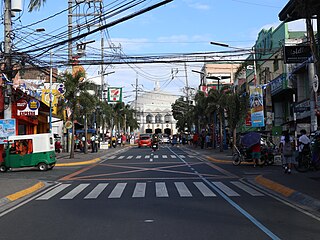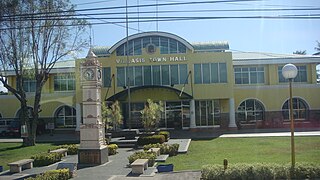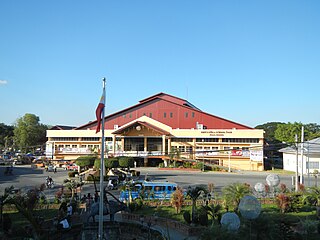
The barangay, historically referred to as barrio, is the smallest administrative division in the Philippines. Named after the precolonial polities of the same name, modern barangays are political subdivisions of cities and municipalities which are analogous to villages, districts, neighborhoods, suburbs, or boroughs. The word barangay originated from balangay, a type of boat used by a group of Austronesian peoples when they migrated to the Philippines.

A municipality is a local government unit (LGU) in the Philippines. It is distinct from city, which is a different category of local government unit. Provinces of the Philippines are divided into cities and municipalities, which in turn, are divided into barangays – villages. As of June 30, 2024, there are 1,493 municipalities across the country.

Malinao, officially the Municipality of Malinao, is a municipality in the province of Aklan, Philippines. According to the 2020 census, it has a population of 24,517 people.

Antipolo, officially the City of Antipolo, is a component city and capital of the province of Rizal, Philippines. According to the 2020 census, it has a population of 887,399 people. It is the most populous city in Rizal Province and in Calabarzon region, and the seventh most-populous city in the Philippines. It is also the most populated city under the component city status.

Vigan, officially the City of Vigan, is a component city and capital of the province of Ilocos Sur, Philippines. According to the 2020 census, it has a population of 53,935 people.

Camiling, officially the Municipality of Camiling,, is a municipality in the province of Tarlac in the Philippines. According to the 2020 census, it has a population of 87,319 people.

Imus, officially the City of Imus, is a component city and de jure capital of the province of Cavite, Philippines. According to the 2020 census, it has a population of 496,794 people.

Villasis, officially the Municipality of Villasis, is a municipality in the province of Pangasinan, Philippines. According to the 2020 census, it has a population of 65,047 people.

Agno, officially the Municipality of Agno, is a municipality in the province of Pangasinan, Philippines. According to the 2020 census, it has a population of 29,947 people.

Bugallon, officially the Municipality of Bugallon, is a municipality in the province of Pangasinan, Philippines. According to the 2020 census, it has a population of 74,962 people.

Rosales, officially the Municipality of Rosales, is a municipality in the province of Pangasinan, Philippines. According to the 2020 census, it has a population of 66,711 people.

Santa Barbara, officially the Municipality of Santa Barbara, is a municipality in the province of Pangasinan, Philippines. According to the 2020 census, it has a population of 92,187 people.

Sual, officially the Municipality of Sual, is a municipality in the province of Pangasinan, Philippines. According to the 2020 census, it has a population of 39,091 people.

San Carlos, officially the City of San Carlos, is a component city in the province of Pangasinan, Philippines. According to the 2020 census, it has a population of 205,424 people. It is the most populated city in Pangasinan and the entire Ilocos Region.

Tumauini, officially the Municipality of Tumauini, is a municipality in the province of Isabela, Philippines. According to the 2020 census, it has a population of 70,743 people.

Orani, officially the Municipality of Orani, is a municipality in the province of Bataan, Philippines. According to the 2020 census, it has a population of 70,342 people.

Tarangnan, officially the Municipality of Tarangnan, is a municipality in the province of Samar, Philippines. According to the 2020 census, it has a population of 25,713 people.

Balagtas, officially the Municipality of Balagtas, is a municipality in the province of Bulacan, Philippines. According to the 2020 census, it has a population of 77,018 people.

Capas, officially the Municipality of Capas, is a municipality in the province of Tarlac, Philippines, and one of the richest towns in the province. The town also consists of numerous subdivisions and exclusive villages.

Unisan, officially the Municipality of Unisan, is a municipality in the province of Quezon, Philippines. According to the 2020 census, it has a population of 25,448 people.



























